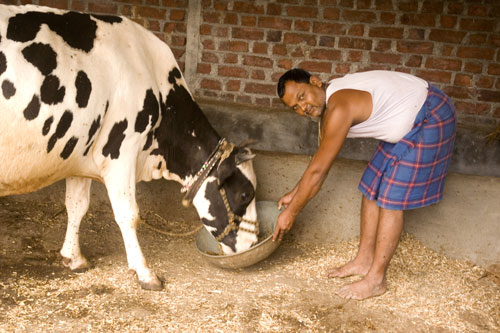Total Mixed Ration (TMR) is a method of feeding dairy cattle and buffaloes for a handsome profit returns. It features the blended approach; forages, concentrates, protein supplements, minerals and vitamins are mixed and offered as a single feed. The term Total Mixed Ration (TMR) or complete ration (CR) is defined as a quantitative mixture of all dietary ingredients, blended thoroughly without giving any choice to the animal for selection of any specific ingredient. In general, it can be regarded as power foods for animals. One alternate term, partial mixed ration (PMR) is a TMR fed to dairy cows in between bouts of grazing which therefore makes up only part of the cows’ diet. Unlike TMR, it does not provide 100% of the diet.

The purpose of feeding a TMR diet is that each cow can consume the required level of nutrients in each bite. A cow’s ration should include good quality forages, a balance of grains and proteins, vitamins and minerals. The ingredients are blended sufficiently to prevent separation and sorting. Therefore, the cow can do very little sorting for individual ration ingredients. The combined feed is further enriched with necessary supplements and feed additives so that the final mixture is a complete balanced ration, designed for specific category of dairy stock. By being able to manage the TMR daily it provides healthy cows, increases in milk production and reproduction. The key to formulating TMR is maximized dry matter intake, which should be consistent with production and breed.
Several strategies can be used in TMR systems. Separate TMR can be developed for different animal groups. These can be formulated for fresh cows, early lactation cows, and mid- and late-lactation animals, as well as for far off and close-up dry cows. Such multi-group strategies are particularly helpful for meeting the needs of dry cows. One group TMR, on the other hand, can be used for lactating cows with or without top-dress feeding. Cows can be grouped based on actual or fat-corrected milk, days in milk, reproductive status, age, nutrient requirements, and health. Different farms have reasons for adopting different strategies for using TMR and these must be a decision of the farm manager based on many aspects of the operation as well as research and personal preference. In conventional TMR, chopped green fodder or silage are blended with cereals, cereal by-products, protein sources, minerals, vitamins and feed additives in order to provide balanced ration to the dairy animals. However, in smallholder dairy production system that is predominant in India, a crop residue based TMR (also referred to as ‘dry TMR’) is more apt. It can be transported easily and stored for at least 2-3 weeks unlike the conventional TMR.
Benefits
- TMR systems can save labour and reduce overall feeding costs by avoiding refusal.
- The dairy farmer has more control over the feeding program.
- Effective utilization of agricultural crop residues.
- Provides steady supply in all seasons and natural calamities.
- There is enhanced DMI because of improvement in palatability of certain feed ingredients.
- The technology enables formulating of rations specific to the nutritional needs of individual categories of dairy stock.
- The technology is compatible with computerized, modernized and intensive dairy production systems with high production goals.
- It helps in refining and accommodating the scientific principles to traditional ways of animal feeding and wide scale adaptability by all categories of farming communities.
Limiting factors
- Non-availability of major ingredients is constraining for adopting the technology.
- Improper grouping of animals may lead to diverting the nutrients to non-productive animals and in turn, increasing costs of production.
- It is extremely important to keep the mixture exactly the same day after day and to make big changes gradually. Short term adoption of technology is not going to make appreciable gains.
- Not suitable for small scale dairy or individual farming.
- Forage analysis is necessary to make TMR, which requires technical expertise.
- TMR can be used effectively by many dairy farmers, but it is not a substitute for good management.
Future prospects
TMR feeding has been shown to sustain a fuller and higher plateau of lactation curve and higher production than conventional separate feeding. By practicing this, there is huge scope of extended research on value addition. However, there are some limitations for adopting this system as it is not economically viable in small herds as it requires huge machinery and technical expertise. TMR can be used effectively by dairy farmers, but it is not a substitute for good management. In fact, the intensity of management may be increased. Most of all, management skills and competency of the dairy farmer are critical to make this system work effectively. This can be best achieved by the interventions or policies of government in the establishment of TMR feed plants by public-private-partnership (PPP) for efficient supply of TMR to the needy small and medium farmers.
Table 1: TMR formulations for cattle (For 100 kg feed)- (Raja Kishore at al., 2017)
| S.No | Ingredient | Type 1 | Type 2 | Type 3 | Type 4 |
| 1. | Maize/Sorghum/Bajra grains | 10 | 4 | 5 | 6 |
| 2. | Groundnut/Soybean meal | 15 | 15 | 10 | 6 |
| 3. | De-oiled Sunflower cake | 10 | 5 | 4 | 5 |
| 4. | Rice bran/DORB | 22 | 23 | 18 | 10 |
| 5. | Molasses | 10 | 10 | 10 | 10 |
| 6. | Maize/wheat/jowar straw/dry grasses | 30 | 40 | 50 | 60 |
| 7. | Mineral mixture | 2 | 2 | 2 | 2 |
| 8. | Salt | 1 | 1 | 1 | 1 |
Type 1: For high producing dairy animals (more than 20 kg milk/day).
Type 2 and 3: For medium producers, growing heifers and pregnant animals.
Type 4: For dry animals.
References
- Raja Kishore, K., Srinivas Kumar, D. and Raghava Rao, E., 2017. Prospects of Total Mixed Ration (TMR) Feeding in Livestock Production. Energy, 3, p.30.






Be the first to comment